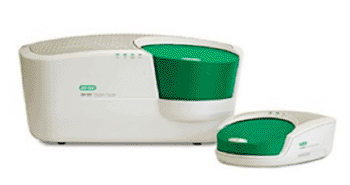Novel Potential Biomarker Reveals Alzheimer's Disease Before Onset
By LabMedica International staff writers
Posted on 04 Sep 2013
The earliest known biomarker associated with the risk of developing Alzheimer's disease has been identified by molecular techniques. Posted on 04 Sep 2013
This novel potential biomarker is present in cerebral spinal fluid (CSF) at least a decade before signs of dementia manifest and will help physicians as at present the only way to accurately diagnose the disease is by postmortem neuropathological analysis.

Image: QX100 Droplet Digital PCR system (Photo courtesy of Bio-Rad Laboratories).
Scientists at the Institute of Biomedical Research (Barcelona, Spain) have demonstrated a decrease in the content of mitochondrial DNA (mtDNA) in CSF in a selected cohort of 282 subjects. This biomarker may be a preclinical indicator for Alzheimer's disease and there may be a directly causative relationship.
Decreased mtDNA levels in CSF reflect the diminished ability of mitochondria to power the brain's neurons, triggering their death. The decrease in the concentration of mtDNA precedes the appearance of well-known biochemical Alzheimer's biomarkers, the Aβ1-42, t-tau, and p-tau proteins. This suggests that the pathophysiological process of Alzheimer's disease starts earlier than previously thought and that mtDNA depletion may be one of the earliest predictors for the disease.
The team was able to both detect and reproducibly quantitate mtDNA using real-time quantitative polymerase chain reaction (qPCR) or droplet digital PCR (ddPCR). To validate their qPCR findings, the team used the QX100 Droplet Digital PCR system Bio-Rad Laboratories, Hercules, CA, USA). Unlike qPCR assays, the QX100 system provides an absolute quantification of target DNA molecules without the need for a standard curve. In addition, an important factor for their CSF analysis was that the Droplet Digital PCR system did not require sample purification to remove PCR inhibitors, as is necessary for qPCR assays.
Ramon Trullas, PhD, the lead author of the study said, “Droplet Digital PCR allowed us to validate our initial qPCR measurements because it provides absolute quantitation at the single-molecule level without relying on a standard curve. As the technology becomes more widely adopted, we anticipate that Droplet Digital PCR will be the future of detecting mtDNA in cerebral spinal fluid." The study was published on August 16, 2013, in the journal Annals of Neurology.
Related Links:
Barcelona Institute of Biomedical Research
Bio-Rad Laboratories













